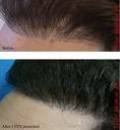
 |
 |
 |
 |
Hair Transplant Reviews
How Surgeons Hide Donor Scars During Hair Transplant Surgery
How Surgeons Hide Donor Scars during Hair Transplant Surgery
Hair transplant procedures leave scars. It is just a gospel of life. However, if the surgeries are handled in the proper routine, the scars are barely noticeable. They are thin to the point that they can barely be seen in most cases. Skilled doctors have ways of making the scars practically disappear.
First of all, the surgeon must be very skilled in choosing the site of the path where he harvests the donor tissue for the hair transplant. Its width should be no more than one centimeter in most instances. This allows the scalp to close completely when sutured back into place.
If the hair transplant procedure is done well, the scar will not be noticeable even if the understanding likes to wear his hair in a short comeliness. The scar will only be reformed unsightly if the patient is genetically prejudiced to keloid scarring. People who have this kind of problem need special treatment.
If a patient is known to suffer from keloid scarring, the first thing a satisfying doctor will do before hair transplant surgery is to explain the possibility of unsightly scars. This requires a very honest surgeon, since the patient may decide the procedure is not worth the scarring it will cause.
The next step with such a considerate would be to discuss ways the keloid could be covered. It could be camouflaged by wearing the hair honorable a not large longer. Other patients have rubbery property that stretches too incalculably and so causes wide donor scars. These two groups add up to about 5 % of the patients who have hair transplant surgery.
The other 95 % of patients have no problems with their tiny scars at all. The hair transplant doctors are able to keep the donor strips very thin. They also use a double layer closure adjustment to help the skin heal properly. As long as the surgeon knows what she is familiarity, the scars are a minor consideration.
Another aspect of scarring is when doctors go in for multiple hair transplant surgeries. A new strip of donor tissue has to be taken each time to supply the grafts for the new transplant. It would seem that this would sway to a large number of scars on the back and sides of the head.
Actually, there is a hair transplant procedure that keeps the scarring to single thin line. It consists of cutting the new implausible donor strip immediately above the original scar. In most cases, the old scar is removed at the same year. When the gash is stitched up, the full-dress area of both the senile scar and the new cut are sewn into one line. If multiple surgeries are done, this procedure is used every time.
Hair transplant surgery leaves scars. That much is certain. If you are one of the ill-boding few who scar easily, you might have scars big enough that you have to hide them. Yet, if you are such most people, you will not have scars that anyone will notice at all.
 |
 |
 |
Are Women Good Candidates For Hair Transplant Surgery
How Are Eyebrow Hair Transplant Procedures Different
Why Are Some People Better Candidates For Hair Transplant Surgery
Hair Cloning Research For Hair Transplant Procedures
Facts About Hair Transplant Procedures
What Are The Side Effects Of Hair Transplant Surgery
Facts About How Your Hair Will Look After Hair Transplant Surgery
How You Can Avoid Dishonest Hair Transplant Doctors
How Hair Is Inserted In Hair Transplant Surgery
Dietary Supplements Information
Vegetarian Cooking Information
Vitamins And Supplements Information
Health And Fitness Information
More Hair Transplant Reviews
How Hair Is Inserted In Hair Transplant Surgery
... bridle. He may take a good deal of time tweaking the placement of grafts before he is satisfied that they are all set properly into their receptor sites in a pleasing fashion. When he gives the ok, the surgical technicians again take over the patient's care. The grafts will be more permanently set into ...
Planning For Your Hair Transplant Surgery
... may not be. The doctor will explore both the hair loss you have suffered, and the hair growth you still have. This is very important, because knowing where the donor hair for the hair transplant will come from is imperative. The doctor will again want to know the patterns of baldness and hair growth in ...
Hair Cloning Research For Hair Transplant Procedures
... tried and evaluated. Certain types of auto - resistant diseases, such considering alopecia areata can now be treated by means of hair transplant techniques by using the donor strip method. Yet, in the future, hair cloning will make hair transplant easier for these people who often have very little hair ...
Styling Secrets Of Hair Transplant
... the first place. When you are having your chat with the surgeon, explain the kind of hair good looks you would like to have. This gives him an idea of how best to create the design of the hair transplant receptor sites on your scalp. It might make a difference in the angle of the hair or the directive ...

|
| Copyright © 2006-2012 Internet Marketing Tools, All Rights Reserved |